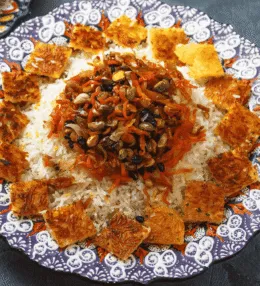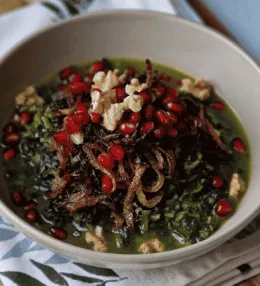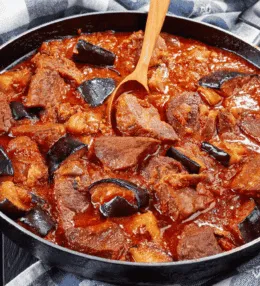
- View
Table of Contents
ToggleThukpa is one of Nepal’s most comforting and soul warming dishes, often enjoyed during cold evenings in the Himalayan regions. This noodle soup, rich in flavour and heartiness, brings together vegetables, meat, and aromatic spices in a single bowl that speaks of tradition, warmth, and community.
Though originally enjoyed in the mountainous areas, Thukpa has found its way into Nepali homes across the country. Whether it’s served during a family dinner or at a roadside eatery in Kathmandu, this dish offers a sense of home with every spoonful. It’s filling, nourishing, and deeply satisfying.
Want to dive deeper into Nepalese Cuisine? Don’t miss our post on 15 Traditional Nepalese Foods to Try
What Is Thukpa?
Thukpa is a noodle soup that combines hand cut noodles with a savoury broth filled with vegetables, spices, and either chicken, beef, goat, or sometimes tofu. While simple in concept, each region and household adds its own flair, making no two bowls quite the same.
What makes Thukpa stand out is the way it brings balance. The broth is both robust and refreshing, the noodles hearty without being heavy, and the vegetables bring colour and crunch. Served piping hot, it’s a dish that feels especially comforting in colder weather.
Ingredients and Taste
The broth is the soul of Thukpa. It is typically made by simmering onions, garlic, tomatoes, ginger, and green chillies with warm spices like turmeric, cumin, and coriander. These ingredients create a deeply flavourful base that carries both depth and brightness.
Noodles are added next, often freshly prepared or thick and chewy if store bought. Vegetables such as cabbage, carrots, and bell peppers are stirred in along with pieces of meat or tofu, depending on preference. The final result is a satisfying, spicy and slightly tangy soup.
The taste of Thukpa is layered and lively. There’s a gentle heat from the chillies, a fresh zing from ginger, and a roundness that comes from slow simmering. It’s neither too oily nor overly rich. Instead, it’s clean, comforting, and just spicy enough to make your cheeks glow.
A Taste of History
Thukpa’s roots lie in the eastern Himalayan regions, particularly among the Tibetan and Sherpa communities. It is believed to have Tibetan origins, where noodle soups are a staple against the cold mountain climate. In Nepal, it was adopted and adapted over time.
The dish gained popularity in Nepal’s eastern hills, especially in areas like Ilam and Taplejung, where the climate mirrors that of its Tibetan neighbours. As people migrated and communities grew, Thukpa travelled with them, evolving along the way.
Today, Thukpa is a staple not only in Nepal’s highlands but also in urban centres. Street vendors serve it with their own spice mixes, and families have passed down their recipes for generations. It’s become more than just food. It’s a cultural bridge between heritage and the everyday.
From a quiet kitchen in the hills to a bustling market stall in the city, Thukpa carries with it the essence of Nepali life. It’s a reminder that the simplest dishes often tell the most meaningful stories. When you eat Thukpa, you’re tasting more than a meal. You’re tasting a memory.
How to Make Nepalese Thukpa
Thukpa is a hearty noodle soup from the Himalayas, deeply rooted in Tibetan and Nepalese culture. This warming bowl brings together aromatic spices, wholesome vegetables, and tender meat in a rich broth, finished with slurpy noodles. Expect layers of flavour in every spoonful. Give your ingredients time to simmer and develop depth, and always taste your broth before serving. See the recipe card at the bottom for printable directions
Ingredients
For the Soup Base:
- 2 tablespoons mustard oil (or vegetable oil)
- 1 large onion, finely sliced
- 1 tablespoon ginger and garlic paste
- 2 medium tomatoes, chopped
- 1 teaspoon turmeric powder
- 1 teaspoon cumin powder
- 1 teaspoon coriander powder
- 1 teaspoon red chilli powder (adjust to taste)
- 6 cups chicken or vegetable stock
- Salt, to taste
For the Meat (optional):
- 250 grams boneless chicken or mutton, cut into bite sized pieces
- 1 teaspoon turmeric powder
- 1 teaspoon cumin powder
- 1 tablespoon yoghurt
- Salt, to taste
For the Vegetables:
- 1 cup shredded cabbage
- 1 medium carrot, julienned
- 1 bell pepper, thinly sliced
- 1 cup chopped spinach
For the Noodles:
- 300 grams egg noodles or rice noodles
For Garnish:
- 2 green chillies, chopped
- Juice of 1 lime
- Fresh coriander, finely chopped
Cooking Instructions
Step 1: Marinate the Meat
To begin, mix the chicken or mutton with turmeric, cumin, yoghurt, and a pinch of salt in a bowl. Cover and let it marinate for at least 20 minutes. This allows the flavours to penetrate deeply and keeps the meat tender during cooking.
Step 2: Prepare the Noodles
Boil water in a separate pot, add the noodles, and cook until just tender. Drain, rinse with cold water, and toss lightly in oil to prevent sticking. Set aside for serving.
Step 3: Build the Flavour Base
Heat mustard oil in a large pot over medium heat. Once hot, add onions and sauté until golden brown. Stir in the ginger and garlic paste and cook until aromatic.
Step 4: Simmer the Spices
Add chopped tomatoes, turmeric, cumin, coriander, and chilli powder. Cook down until the tomatoes break apart and the mixture thickens. This spice paste forms the core flavour of your broth.
Step 5: Add the Marinated Meat
Stir in the marinated meat and cook until lightly browned. This seals in the spices and brings umami depth to the broth. Stir occasionally to avoid sticking.
Step 6: Pour in the Stock
Pour in the chicken or vegetable stock. Season with salt and bring the soup to a boil. Lower the heat and let it simmer for 20 minutes, allowing the broth to absorb all the flavours.
Step 7: Add the Vegetables
Toss in cabbage, carrots, bell pepper, and spinach. Simmer for an additional 5 to 7 minutes, just until the vegetables are tender but still vibrant.
Step 8: Adjust Seasoning
Taste the broth and adjust salt or chilli according to your preference. For more zing, squeeze in half of the lime juice now and reserve the rest for garnish.
Step 9: Assemble the Bowls
Divide the cooked noodles evenly into four bowls. Ladle the hot soup over the noodles, ensuring each bowl gets a good mix of broth, meat, and vegetables.
Final Step: For Serving
Top each bowl with chopped coriander, green chillies, and a squeeze of lime. Serve hot with extra lime wedges or a side of chilli paste if desired. The soup should be rich, lightly spicy, and deeply comforting.
Cooking Tips for Perfect Thukpa
- Use mustard oil for authenticity but heat it until it smokes slightly to mellow its pungency before cooking.
- Simmer the broth slowly to allow the spices and meat to release maximum flavour.
- Add vegetables towards the end to keep them bright and crisp.
- Boil noodles separately to prevent the broth from turning starchy and cloudy.
- Chilli level is flexible adjust it depending on your preference or add sliced chillies at the table.

Nepali Thukpa (Noodle Soup)
Ingredients
For the Soup Base:
- 2 tablespoons mustard oil or vegetable oil
- 1 large onion finely sliced
- 1 tablespoon ginger and garlic paste
- 2 medium tomatoes chopped
- 1 teaspoon turmeric powder
- 1 teaspoon cumin powder
- 1 teaspoon coriander powder
- 1 teaspoon red chilli powder adjust to taste
- 6 cups chicken or vegetable stock
- Salt to taste
For the Meat (optional):
- 250 grams boneless chicken or mutton cut into bite sized pieces
- 1 teaspoon turmeric powder
- 1 teaspoon cumin powder
- 1 tablespoon yoghurt
- Salt to taste
For the Vegetables:
- 1 cup shredded cabbage
- 1 medium carrot julienned
- 1 bell pepper thinly sliced
- 1 cup chopped spinach
For the Noodles:
- 300 grams egg noodles or rice noodles
For Garnish:
- 2 green chillies chopped
- Juice of 1 lime
- Fresh coriander finely chopped
Instructions
- To begin, mix the chicken or mutton with turmeric, cumin, yoghurt, and a pinch of salt in a bowl. Cover and let it marinate for at least 20 minutes. This allows the flavours to penetrate deeply and keeps the meat tender during cooking.
- Boil water in a separate pot, add the noodles, and cook until just tender. Drain, rinse with cold water, and toss lightly in oil to prevent sticking. Set aside for serving.
- Heat mustard oil in a large pot over medium heat. Once hot, add onions and sauté until golden brown. Stir in the ginger and garlic paste and cook until aromatic.
- Add chopped tomatoes, turmeric, cumin, coriander, and chilli powder. Cook down until the tomatoes break apart and the mixture thickens. This spice paste forms the core flavour of your broth.
- Stir in the marinated meat and cook until lightly browned. This seals in the spices and brings umami depth to the broth. Stir occasionally to avoid sticking.
- Pour in the chicken or vegetable stock. Season with salt and bring the soup to a boil. Lower the heat and let it simmer for 20 minutes, allowing the broth to absorb all the flavours.
- Toss in cabbage, carrots, bell pepper, and spinach. Simmer for an additional 5 to 7 minutes, just until the vegetables are tender but still vibrant.
- Taste the broth and adjust salt or chilli according to your preference. For more zing, squeeze in half of the lime juice now and reserve the rest for garnish.
- Divide the cooked noodles evenly into four bowls. Ladle the hot soup over the noodles, ensuring each bowl gets a good mix of broth, meat, and vegetables.
- Top each bowl with chopped coriander, green chillies, and a squeeze of lime. Serve hot with extra lime wedges or a side of chilli paste if desired. The soup should be rich, lightly spicy, and deeply comforting.
Nutrition
You May Also Like







Leave a Review